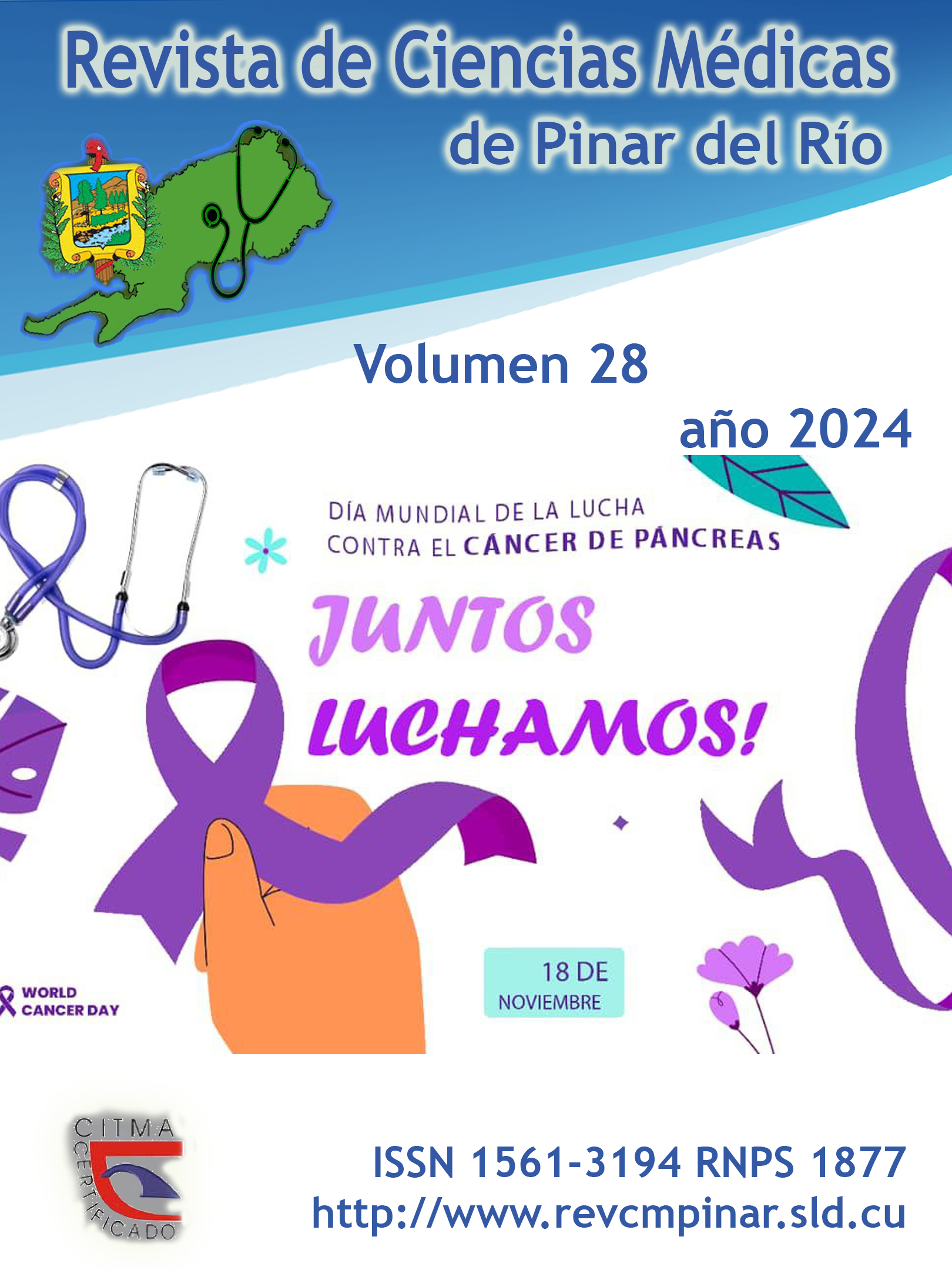The environmental influence on the health of students with behavioral disorders
Keywords:
ENVIRONMENTAL EDUCATION, HEALTH, CONDUCT DISORDER.Abstract
Introduction: COVID-19 represented a global health crisis and revealed the fragility of the interdependent relationship with nature; hence the need to train teachers from an environmentalist conception so that they have a positive impact on the health of students with behavioral disorders.
Objective: to evaluate the effectiveness of a guidance manual for teachers related to environmental aspects, which can influence the health of students with behavioral disorders.
Methods: a pedagogical study was carried out at the "Águedo Morales Reina" special school between September 2021 and June 2022, using document analysis, scientific observation, interviews and descriptive statistics, in a sample of five students with mental disorders. behavior with health problems, five specialists (speech therapist, educational psychologist, art instructors) and two teachers from special schools.
Results: it is specified in a guidance manual for teachers that offers suggestions on environmental aspects to achieve a healthy education for students with behavioral disorders. It constitutes a resource to help overcome the diagnosis in the shortest possible time, by taking into account the positive and negative implications of the environment on the health of students with behavioral disorders.
Conclusions: the guidance manual confirmed its theoretical, methodological and practical value, by confirming higher levels in the use of environmental aspects for the development of quality health in the selected students in the province of Pinar del Río.
Downloads
References
1. Alonso B. Historia de la Educación Ambiental. “La Educación Ambiental en el Siglo XX”. Editado por: Asociación Española de Educación Ambiental. España; 2010.
2. UNESCO. Educación para el Desarrollo Sostenible: objetivos de aprendizaje [Internet]. Organización de las Naciones Unidas para la Educación, la Ciencia y la Cultura, UNESCO Digital Library; 2020 [citado 20/05/2021]. Disponible en: https://unesdoc.unesco.org/ark:/48223/pf0000252423
3. Huerta C. A los 44 años del inicio de los modelos ambientales y a los 30 años del despertar de América Latina [Internet]. Linkedin; 12 Jun 2018 [citado 20/05/2021]: 3p. Disponible en: https://es.linkedin.com/pulse/44-a%C3%B1os-del-inicio-de-los-modelos-ambientales-y-30-despertar-huerta
4. Martínez HF. Fundamentos de la Educación Ambiental [Internet]. Belgrado: Expresión; 2018 [citado 20/05/2021]. Disponible en: https://www.unescotexea.org/ext/manual/htm/fundamentos.html
5. Estela RM. Educación Ambiental [Internet]. Argentina; 2020 [Citado 20/05/2021]. Disponible en: https://concepto.de/educacion-ambiental/
6. Gaceta Oficial. Ley de Medio Ambiente 150/2023 [Internet]. Gaceta Oficial. Cuba; 2023 [Citado 20/05/2021]. Disponible en: https://www.parlamentocubano.gob.cu/sites/default/files/documento/2023-10/goc-2023-o87.pdf
7. Eschenhagen ML. Algunas observaciones sobre la década de la Educación Ambiental para el desarrollo sostenible y la tarea pendiente de la Educación Ambiental Superior. Pesquisa em Educação Ambiental [Internet]. 2016 [citado 20/05/2021]; 11(2): 24-35. Disponible en: http://dx.doi.org/10.18675/2177-580X.vol11.n2.p24-35
8. Severiche SC, Gómez BE, Jaimes MJ. La educación ambiental como base cultural y estrategia para el desarrollo sostenible. Rev Est Interd Cienc Soc [Internet]. 2016 [Citado 20/05/2021]; 18(2): 266-281. Disponible en: https://www.redalyc.org/pdf/993/99345727007.pdf
9. Peña RB. Acciones estratégicas para fomentar la cultura ambiental en San José. [Internet]. Las Tunas. Cuba; 2019 [Citado 20/05/2021]: 7 p. Disponible en: https://www.gestiopolis.com/acciones-estrategicas-para-fomentar-la-cultura-ambiental-san-jose-las-tunas-cuba/
10. Rodríguez E, Quintanilla AL. Relación ser humano-naturaleza: Desarrollo, adaptabilidad y posicionamiento hacia la búsqueda de bienestar subjetivo. Avan Invest Agrop [Internet]. 2019 [Citado 20/05/2021]; 23(3): 7-18. Disponible en: https://www.redalyc.org/journal/837/83762317002/83762317002.pdf
11. Moreno Sánchez AR. Salud y medio ambiente. Rev Fac Med (Méx) [Internet]. 2022 Jun [citado 08/01/2022]; 65(3): 8-18. Disponible en: http://www.scielo.org.mx/scielo.php?script=sci_arttext&pid=S002617422022000300008&lng=es.
12. Asociación Americana de Psiquiatría. Manual psiquiátrico y estadístico de los trastornos mentales (DSM-V) [Internet]. España: Editorial Mansso s.a; 2013. [citado 08/01/2022]. Disponible en: http://www.medicapanamericana.com/Libros/Libro/4949/DSM5-Manual- Diagnostico-y-Estadistico-de-los-Trastornos-Mentales.html
13. Valdés Valdés AI, Fernández Pérez de Alejo G, Perojo Martínez DA, Castro Pérez G, Martínez García A. Laboratorio logopédico para la atención a la disfonía desde la formación inicial y permanente. Rev Cienc Médicas [Internet]. 2016 [citado 06/03/2018]; 20(6): 85-93. Disponible en: http://scielo.sld.cu/scielo.php?script=sci_arttext&pid=S1561-31942016000600012
14. Vázquez Campos J, Conill Armenteros JA, Sotolongo Peña RC. El colectivo logopédico. Una mirada desde la formación inicial y permanente del logopeda. Rev Cienc Médicas [Internet]. 2019 [citado 08/01/2022]; 23(3): 418-426. Disponible en: http://www.revcmpinar.sld.cu/index.php/publicaciones/article/view/3858
15. Pollé TM, Chávez HS, Soris LT. Acciones estratégicas para la educación ambiental comunitaria en los estudiantes de la Universidad de Ciencias Médicas de Camagüey. Rev Hum Med [Internet]. 2015 [citado 20/05/2021]; 15(1): [aprox. 7 p]. Disponible en: https://scielo.sld.cu/scielo.php?script=sci_arttex&pid=S1727-81202015000100008
Downloads
Published
How to Cite
Issue
Section
License
Authors who have publications with this journal agree to the following terms: Authors will retain their copyrights and grant the journal the right of first publication of their work, which will be publication of their work, which will be simultaneously subject to the Creative Commons Attribution License (CC-BY-NC 4.0) that allows third parties to share the work as long as its author and first publication in this journal are indicated.
Authors may adopt other non-exclusive license agreements for distribution of the published version of the work (e.g.: deposit it in an institutional telematic archive or publish it in a volume). Likewise, and according to the recommendations of the Medical Sciences Editorial (ECIMED), authors must declare in each article their contribution according to the CRediT taxonomy (contributor roles). This taxonomy includes 14 roles, which can be used to represent the tasks typically performed by contributors in scientific academic production. It should be consulted in monograph) whenever initial publication in this journal is indicated. Authors are allowed and encouraged to disseminate their work through the Internet (e.g., in institutional telematic archives or on their web page) before and during the submission process, which may produce interesting exchanges and increase citations of the published work. (See The effect of open access). https://casrai.org/credit/



